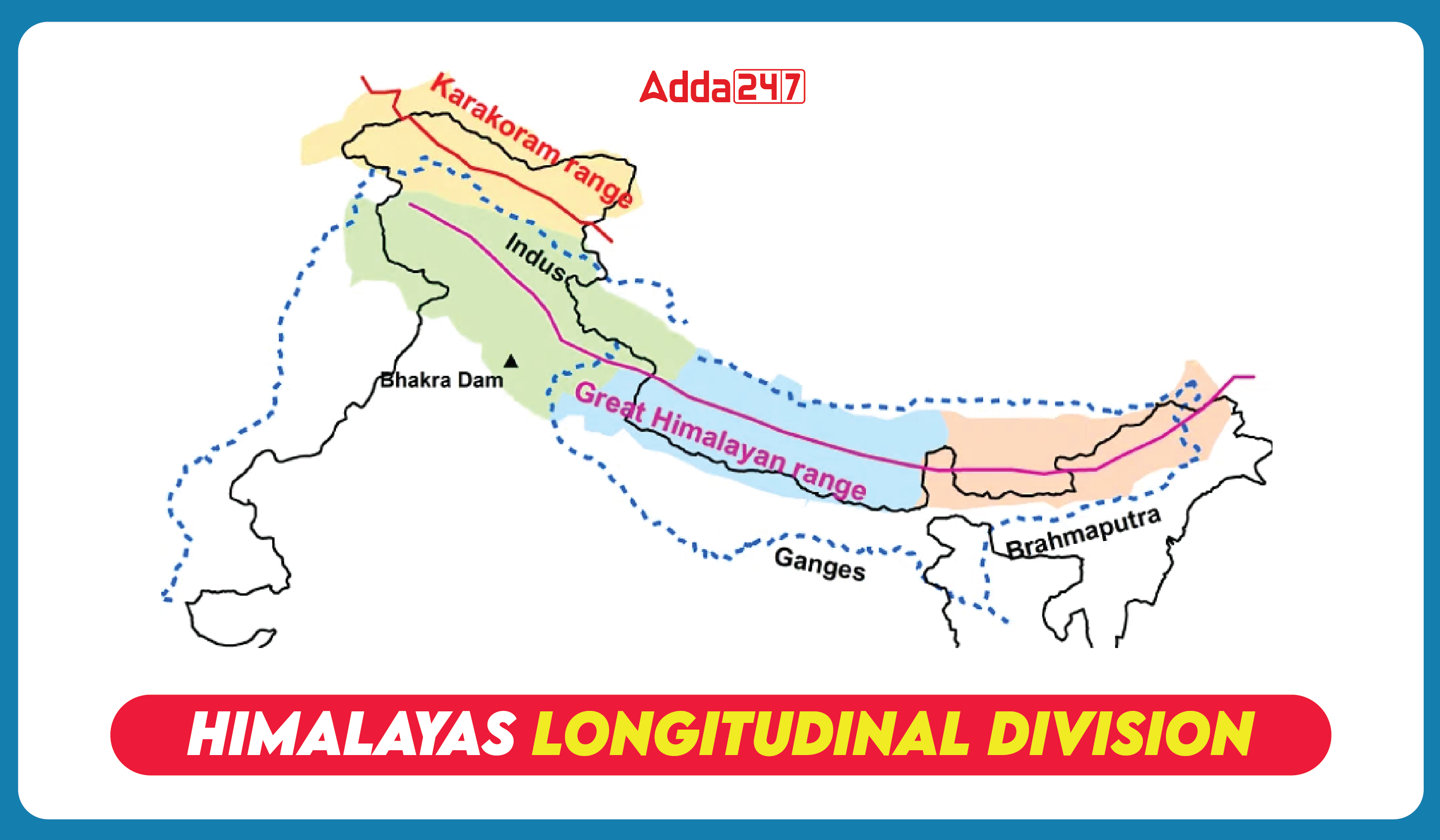Table of Contents
The Himalayas Longitudinal Division encompasses three main divisions: the Kashmir/Punjab/Himachal Himalayas, the Kumaun Himalayas, and the Central/Nepal Himalayas. These divisions, also known as the Regional Divisions of the Indian Himalayas, are crucial components of the GS Paper 1 Syllabus for the UPSC Mains curriculum as well as GS Paper 1 of Prelims.
The Himalayas are further categorized from north to south into the Greater Himalayas or Himadari, the Lesser Himalayas or Himachal, and the Shiwalik or Outer Himalayas. This article aims to provide comprehensive information on the Longitudinal Division of the Himalayas.
Himalayas Longitudinal Division
The Longitudinal Division of the Himalayas is divided into four sections, running from west to east, based on their geographical locations and the rivers that lie between them:
Punjab Himalayas: Located between the Indus and Sutlej Rivers, this section is also referred to as the Kashmir Himalaya and Himachal Himalaya.
Kumaon Himalayas: Found between the Sutlej and Kali Rivers, this region covers parts of Uttarakhand.
Nepal Himalayas: Stretching from the Kali River to the Tista River, this section encompasses the majority of the Himalayas within Nepal.
Assam Himalayas: Extending from the Tista River to the Dihang River, this range lies in the eastern Himalayas, covering parts of Assam.
Indian Geography Notes for UPSC
Himalayas Division From West to East
Read here in detail about the Himalayas Division from West to East
Kashmir /Punjab/ Himachal Himalayas
The Kashmir Himalayas stretch between the Indus River and the Sutlej, encompassing a considerable portion of Jammu and Kashmir and Himachal Pradesh. This region is also commonly referred to as the Punjab Himalayas.
In the Jammu and Kashmir region, you’ll find a landscape marked by towering snow-capped peaks, deep valleys, interlocked spurs, and numerous high mountain passes. This vast range extends for approximately 700km in length and 500km in width, reaching heights of up to 3000m and hosting a plethora of glaciers. The Ladakh area experiences the harsh conditions of a cold desert, while the Kashmir valley, nestled within this division and surrounded by the Greater and Lesser Himalayas, boasts the unique Karewa soil, renowned for its cultivation of saffron and other dry fruits.
Key mountain passes in the Kashmir Himalayas include Pir Panjal, Banihal, Zoji La, Burzil, Khardungla, Pensi-La, Saser-La, Lanak-La, Jara-La, Tasaka-La, Umasi-La, and Qara-Tagh-La. Notable snow-capped peaks in the region include Nanda Devi, Trisul, Nunkun, Kamath, and Nanga Parbat.
In the Himachal Pradesh Region, you’ll find a diverse representation of all three ranges—the Greater, Lesser, and Outer Himalayas. The northern slopes of the Himachal Himalayas are adorned with dense forests, expansive plains, and shimmering lakes, while the southern slopes are rugged and covered in thick forests. Notable locales such as the Kangra Valley and Kullu-Manali are renowned for their high productivity, lush orchards, and breathtaking landscapes.
This region is home to several important hill stations including Dalhousie, Shimla, Chamba, Kullu-Manali, and Dharamsala. Key mountain passes such as Rohtang Pass, Bara-Lacha, and Shipki La are significant features of the landscape.
Kumaun Himalayas
The Kumaun Himalayas, situated between the Satluj and Kali Rivers, boast the towering peak of Nanda Devi as their highest point. Other notable peaks in this region include Trisul, Kedarnath, Dunagiri, Kamet, Badrinath, Jaonli, Gangotri, and Bandarpunch. Among the significant glaciers found here are Pindari, Gangotri, and Milam.
Prominent hill stations dotting the landscape include Mussoorie, Nainital, Ranikhet, Almora, and Bageshwar. Key passes in the Kumaun Himalayas include Thaga La, Muling La, Mana, Mangsha Dhura, and Lipu Lekh.
Central/Nepal Himalayas
The Central or Nepal Himalayas stretch from the Kali River to the Tista River, with the majority of this range located in Nepal. The far eastern section, however, lies in the Sikkim Himalayas. This region is home to some of the world’s most iconic peaks, including Mt. Everest, Kanchenjunga, Makalu, Dhaulagiri, Annapurna, Manaslu, and Gosainath. Notable mountain passes in this area include Nathu La and Jelep La, both of which hold strategic significance.
Assam/ Eastern Himalayas
- This division extends between the Tista and Brahmaputra Rivers (Dihang), covering Arunachal Pradesh in India and Bhutan.
- As it reaches the southern border of Arunachal Pradesh, it bends southward, forming Purvanchal, which stretches from Nagaland, Manipur, and Mizoram, to Tripura in a North-South direction.
- Purvanchal connects with the Meghalaya Plateau in the west and extends further into the Myanmar mountain chain, reaching the Andaman and Nicobar Islands as well as the Archipelago of Indonesia.
- The Himalayas rise sharply from the plains of Assam and narrow as they approach the foothills of the Shiwaliks.
- Notable hills in this region include the Aka Hills, Dafla Hills, Miri Hills, Abor Hills, Mishmi Hills, and Namcha Barwa.
- Significant features in the eastern Himalayas encompass Pakai Bum, Manipur Hills, Blue Mountain, Tripura Range, and Brail Range.
- Key passes in the area include Bomdi La, Yonggyap, Diphu, Pangsau, Tse La, Dihang, Debang, Tunga, and Bom La.



 TSPSC Group 1 Question Paper 2024, Downl...
TSPSC Group 1 Question Paper 2024, Downl...
 TSPSC Group 1 Answer key 2024 Out, Downl...
TSPSC Group 1 Answer key 2024 Out, Downl...
 UPSC Prelims 2024 Question Paper, Downlo...
UPSC Prelims 2024 Question Paper, Downlo...





